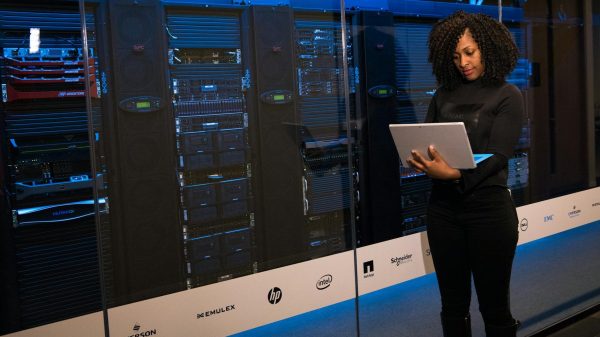This has become quite popular with smartphones, where applications such as Google Photos saved a copy of your photos (unlimited until recently).
It was also the place where WhatsApp chats were stored and which, when we changed smartphones, we recovered almost as if by magic. But the cloud is much more than all this. Let’s take a look.
Definition
What is the cloud? If you ask us, the answer can be very broad. In general terms, we could call the cloud “a place where our stuff is stored and is accessible from the internet”. The definition is unclear, but we could say that the cloud is a term used to describe a globally distributed platform or network of servers that operate as a single ecosystem. These platforms are designed to provide computing, storage, streaming or application execution services, among others.
The difference between cloud and on-premise, which is the traditional data centre service, is that certain elements are managed by a provider, facilitating administration and relieving customers of certain tasks.
The metaphor
Let’s imagine a pizza with its ingredients, as a service, as if it were an on-premise service, a Cloud IaaS, PaaS or SaaS service.
In on-premise we have access to the entire physical infrastructure (we can physically access the datacenter and get to the server), which in Cloud we do not. Depending on the level of administration that we have as IT administrators, we can classify the services in 3 main blocks:
IaaS (Infrastructure as a Service): We have logical access to the server level, but not to the physical or virtualisation infrastructure that hosts it.
PasS (Product as a Service): We have access to the application and data (e.g. a web server), but not to the server in a logical way as in IaaS.
SaaS (Software as a Service): We have access to the service directly (e.g. Outlook), but we have no access to the server, the application or the data as it is managed entirely by the service provider.
We can group the Clouds into three main groups
Public Cloud
It is a public access platform (via the Internet) operated by large companies (Hyperscalars). These hyperscalars are the ones that provide computing, storage and application execution services in a globally distributed and transparent way for the user.
We could say that it is a virtual datacenter, of which we know neither location, nor is it initially limited. And in which you can grow quickly, since the creation or expansion of servers, environments or storage can be done at the click of a mouse and in just a few minutes.
To manage these services, a web portal is usually used that is accessible from the internet. This platform stands out for having IaaS, PaaS, or SaaS services from which the Infrastructure part is managed directly by the hyperscalar, simplifying the service administration mode as you have seen in the previous example.
It highlights its billing model, which in these cases is pay-per-use. For example, computing and operating system licences are only billed for the time the server is on. Outgoing network traffic is billed. PaaS databases can be billed for computing and licenses per query executed and not for the time they are available. Although they can also be configured in a traditional way, among other examples.
The infrastructure is generally shared (although isolated) with other customers and virtualised, with the option of dedicated infrastructure. Although access to the platform is public (via the internet), access to servers, databases or other services can be done with private IP addressing if desired, through VPN or a dedicated server. It offers automatic scaling services of the infrastructure based on usage patterns and consumption by users, as well as high redundancy and fault tolerance.
It offers a wide range of services including compute services (servers, storage), backup and DR solutions, Big Data solutions, as well as pre-configured and licensed third-party SaaS or IaaS elements available in a Marketplace.
It is a platform suitable for companies that cannot afford the high cost of acquiring their own on-premise environment, such as start-ups.
The most common hyperscalars are AWS (Amazon), Azure (Microsoft), Google Cloud Platform, and Oracle Cloud Infrastructure. These currently account for a large percentage of the services we use on a daily basis.
Private Cloud
Unlike the Public Cloud, the Private Cloud generally only offers IaaS services, although it can also offer PaaS services. The IT administrator has logical access to the servers but not to the physical and virtualisation infrastructure, which is delegated to the service provider to manage. Depending on the service provider, it is possible to have a web tool to self-manage extensions or server creations, providing scalability and elasticity just like the Public Cloud.
In this type of Cloud, the billing model is usually fixed (i.e. whether the server is on or off, you pay the same). The infrastructure is dedicated, unlike the Public Cloud, which provides a higher level of security and confidentiality.
Logical access to the servers is usually done by using a VPN or a dedicated Hopserver, as the IP addressing is usually private. It is usually hosted on the service provider’s premises, although it can be extended at times to the customer’s own premises. Although it may seem similar to on-premise, it is not, as there is a service provider that manages certain elements. On-premise also does not guarantee scalability and elasticity.
Hybrid Cloud
It is a mixture of the two. In this scenario, depending on the service and the confidentiality or cost, we can have services running in the Private Cloud and others in the Public Cloud. In these services, the interconnection between the two Clouds stands out, which can be either through the Internet with a VPN S2S (site to site), or with a Cloud Connect, which would be a dedicated point to point connection through a telecommunications provider. Interconnection with on-premise is also supported in these scenarios if necessary.
Conclusions
There is no one option that is better than another and all are valid depending on the situation and needs of each company. For example, in general, a server running 24×7 is usually more expensive in the Public Cloud than in the Private Cloud, but it is also possible that using a PaaS database in the Public Cloud is cheaper than if it is used in the IaaS model of the Private Cloud.
My view is that in general, it would be appropriate to go to a hybrid model whenever possible, to have a balance between cost and service offerings.









